Vacuum breakers
 Vacuum breaker Yoshitake VB-7, 7S
Vacuum breaker Yoshitake VB-7, 7S
- Manufacturer: Yoshitake
- Material: brass, cast bronze/cast stainless steel, stainless steel
 Individual heating station of the heating system according to an independent connection scheme
Individual heating station of the heating system according to an independent connection scheme
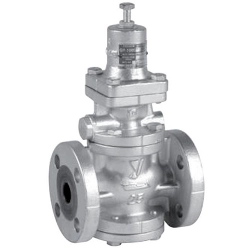 Reducing valve for steam Yoshitake GP-1000EN
Reducing valve for steam Yoshitake GP-1000EN
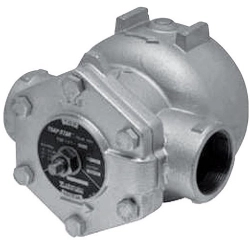 Float steam trap Yoshitake TSF-10
Float steam trap Yoshitake TSF-10
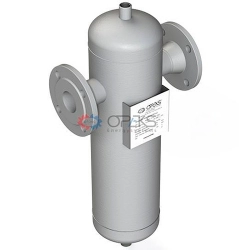 Centrifugal steam separator OPEKS-1-SC16-1-F50
Centrifugal steam separator OPEKS-1-SC16-1-F50
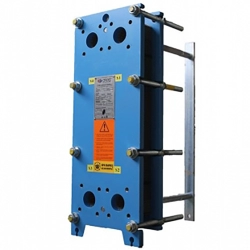 Plate heat exchanger THERMAKS РТА (GC)-16
Plate heat exchanger THERMAKS РТА (GC)-16
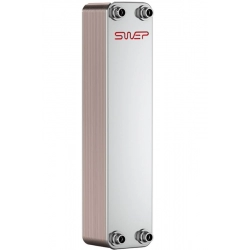 Brazed heat exchanger SWEP B25T
Brazed heat exchanger SWEP B25T
 Brazed heat exchanger SWEP B25THx20
Brazed heat exchanger SWEP B25THx20
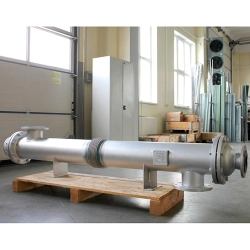 Shell and tube coolers
Shell and tube coolers
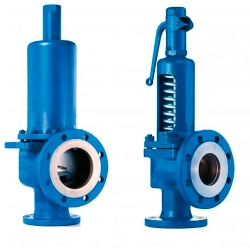 Safety valve LESER 441/442
Safety valve LESER 441/442
Vacuum breakers
What can cause a partial vacuum in work equipment?
It’s a paradox, but heat exchangers, boiler equipment, pipeline sections and tanks designed to work with various gas and liquid working media at high working pressures can suffer from internal vacuum (evacuation) that occurs inside closed pipeline systems under certain conditions. The most typical situations that cause evacuation inside an enclosed workspace are:
- Stopping the supply of steam to steam heat exchangers (or stopping steam generation in steam boilers), while simultaneously releasing excess pressure, equalizing the internal pressure in the system with atmospheric. In such a situation, the filling water vapor remaining in the system, while cooling, will inevitably condense into water. As a result of the phase transition from the gaseous state (vapor) to the liquid state (water), the volume of the filling medium of the system drops sharply, and, accordingly, its pressure. This leads to the evacuation of heat exchange or boiler equipment. With a large size and internal volume of such equipment, the degree of its vacuumization can reach rather high values.
- Inconsistent shutdown of the pumping and pumping out pumping equipment, when, when the blower is turned off (or the discharge pipeline is shut off), the pumping of the medium continues to work, inevitably creating a vacuum in the closed space. In such a situation, the degree of evacuation of the system depends on the nature of the working medium (liquid or gas), design features and power characteristics of the pumping equipment.
- Prolonged cessation of the supply (injection) of the liquid medium into the heat exchange equipment, which has a large building height (as an example, the heating system of a high-rise building). As a result, the column of liquid remaining in the system flowing down by gravity can cause serious vacuuming of its upper sections.
Factors of the harmful effect of vacuumization on heat engineering systems
Why is a partial vacuum harmful for closed piping systems, heat engineering and storage equipment? Designed to operate under elevated and very high internal pressures, they are unlikely to collapse or severely deform when subjected to partial vacuum conditions. Unless they will contain very thin-walled pipes, channels and containers. Moreover, with a drop in internal pressure, the temperature point of boiling of liquid condensate will gradually decrease, therefore, high vacuum conditions cannot be achieved in this way.
But the difficult access to the evacuated internal space through technological plugs, covers and hatches can be a serious problem if it is necessary to regulate and maintain heat exchange, boiler, pipeline equipment, as well as if it is necessary to disassemble it. Also, the evacuated space is capable, on occasion, of sucking a variety of debris into the equipment, even a slight bend of the outer walls inside the evacuated container will provoke delamination and peeling of scale and other deposits, which will subsequently adversely affect its performance. In any case, even a partial vacuum inside equipment designed for other operating conditions is an abnormal mode for it, which can lead to various unforeseen consequences.
Purpose, design and principle of operation of the vacuum interrupter
To prevent the evacuation of a closed space inside various apparatus and equipment operating under conditions of increased and high internal pressure, a special type of pipeline protective fittings, called vacuum interrupters, is designed. The recommended installation location for the vacuum breaker is the inlet (inlet) of the heat exchanger, boiler or vessel.
The design of the vacuum interrupter is a classic automatic check valve with a spring-loaded ball shut-off valve. But it is installed, unlike a safety valve, to pass the medium not from the inside of the closed system to the outside, but, on the contrary, to let it pass from the outside to the inside. To work with equipment, the housings or nozzles of which are made of different materials (cast iron, carbon and stainless steel, brass and bronze, aluminum alloys, titanium) try to use vacuum interrupters with housings of the same or electrochemically compatible with them metals, in order to avoid the occurrence of bimetallic galvanic couples, quickly destroyed by corrosion.
The principle of operation of a vacuum interrupter, like a conventional bypass valve, is quite simple. In the operating mode of heating equipment, under conditions of high internal pressure, its ball valve is normally closed. In abnormal situations, when a partial vacuum of a certain value occurs inside the equipment (according to preset parameters or manual settings), the external atmospheric pressure overcomes the pressure spring force, the spool rises above the valve seat and opens the flow area. As a result, the outside air enters the closed system and removes the evacuation conditions, equalizing the internal pressure with atmospheric.

Vacuum breaker selection parameters
The main operating parameters and technical characteristics of the vacuum interrupter are:
- Throughput, in m 3 / min. Apparatus and equipment with a large internal volume may require a high capacity vacuum interrupter.
- Maximum operating pressure of the system, in MPa, bar.
- Maximum working temperature of the medium, degrees C.
- The calculated value of the actuation vacuum, in MPa.
- Mounting dimensions, dimensions of the seating thread.
Vacuum breakers in the range of OPEKS Energysystems
Specializing in the sale of heat and power equipment of its own production, OPEKS Energosystems also strives to offer a wide range of partner equipment to fully meet the needs of our customers. In the segment of vacuum interrupters, we offer products from one of the recognized world leaders in the heating equipment market, the Japanese company Yoshitake, any product of which is characterized only by impeccable quality.
Among the offered models of Yoshitake vacuum interrupters, our customers will be able to choose options with durable cast bodies made of stainless steel, brass and bronze, for heating systems with a maximum operating temperature of up to 200 degrees. With and working pressure up to 1.0 MPa. All offered models of Yoshitake vacuum interrupters strictly comply with the declared operational parameters.

